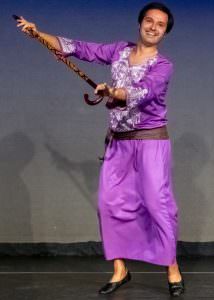In this guest blogpost, Dancer and linguist, Torkom Moysesiyan provides a glimpse into the ancient Egyptian dance of Saidi. Saidi originates in Upper Egypt and is danced by both women and men.
“Saidi dates back to ancient Egypt. It is an Egyptian folkloric dance that derives from the Arabic term, aSSa’yeed, meaning “The Upland,” a geographical area located on both sides of the Nile River in Upper Egypt. The Egyptian Saidi is a martial arts dance that has two variations: altahteeb, performed by men and raqs alaSSaya, performed by women. The tahteeb exemplifies masculinity and a battle scene, whereas in the latter women imitate the combative skills celebrated in the tahteeb.
In tahteeb, performers use a heavyweight stick whereas in raqs aSSaya, women use a light or heavyweight cane, often decorated with beads and sequins. The Saidi movements revolve around striking, spinning, rowing, flipping and twirling. Men performing saidi usually wear a long galabiyya with a turban, and women wear a galabiyaa or long dress with a headscarf. Some of the instruments present in saidi are mizmar (an oboe-like reed instrument), rebaba (a stringed instrument), nay (flute) and tabla (a frame drum with a deep sound). The rhythm of saidi is 4/4, and it can be performed either as a solo or group piece.
The saidi dance from Upper Egypt, known as tahteeb, is important because it helps us learn about the lives of the ancient Egyptians, particularly, how they used it to prepare for a battlefield. What’s more, the saidi dance was inscribed on the walls of Pharaonic temples and performed with a stick by the ancient Egyptians as a tribute to the Pharaoh.
The late Egyptian dance choreographer Mahmoud Reda, created a theatricalized version of the folkloric saidi dance, known in Arabic as Raqs Alassaya, cane dance, specifically for female dancers, imitating the martial arts movement of the tahtib. Saidi is performed during special occasions such as a wedding, birthday, festival or other related celebrations. Raqs Without Borders, a Middle Eastern and North African dance festival often invites native Egyptian artists in NYC to teach and perform Saidi.”
Follow the link before for an example of the work of Torkom Moysesiyan in a theatricalized version of saidi, adapted for stage, and performed in Rochester in 2017 at “Tales of Arabia,” hosted by Katrina Scott. The music is Wala Ya Saidi.
https://www.youtube.com/watch?v=wMn2XJnb_B4

Torkom Movsesiyan wearing a traditional galabeya with a cane, worn by males performing Egyptian saidi dance from a 2018 dance project in NYC, Raqs Revolution. (photo credit: Tevon Miller).
Torkom Moysesiyan is the director of Torkomada, Inc., a multidisciplinary not-for-profit organization, envisions the indigenous and folk dances of the Middle East and North Africa as an important, but neglected diplomatic tool in cultural diplomacy, especially in U.S.-Middle East relations. Headed by Torkom Movsesiyan, a Bulgarian-Armenian trained by dance legends Morocco and Tarik Sultan, Torkomado focuses on Raqs Sharqi, a traditional Egyptian folk dance, popularly known by its misnomer—belly dance. TORKOMADA is a member of UNESCO’s International Dance Council. TORKOMADA currently conducts academic research on dance, builds dance curricula for after-school programs in NYC, and works closely with a foreign language project, where students studying Arabic language can learn it through Middle Eastern music and dance.
No permission is granted to anyone to print, copy, reproduce, distribute, transmit, store, display in public, alter, or modify any materials, including but not limited to articles, documents, videos, icons, or images, published by Torkom Movsesiyan or TORKOMADA, Inc.
